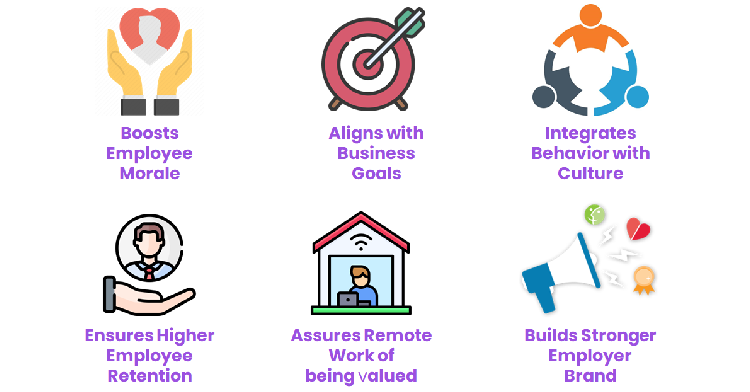1. Boosts Morale and Motivation: Frequent recognition celebrates minor achievements, boosting employee morale and inspiring continuous improvement.
2. Enhances Alignment with Business Goals: Regular recognition helps employees align their efforts with organizational goals, encouraging others to follow suit for similar recognition.
3. Strengthens Organizational Culture and Retention: Frequent recognition fosters a positive work culture, increases employee satisfaction, and boosts retention by reinforcing their value to the organization.
4. Supports Remote Employees and Employer Branding: Regular recognition assures remote employees of their importance and helps build a strong employer brand by enhancing employees’ sense of belonging and pride.
A good recognition program can significantly enhance employees’ happiness and satisfaction. Organizations have also realized that the frequency of employee recognition matters, as it improves the programs’ benefits and ROI.
Developing an effective reward and recognition system is often challenging for most organizations.

This is because the success of such programs depends on multiple factors that impact the level of employee experience, satisfaction, and motivation.
In this context, the following factors should be considered as most important:

The traditional method of recognizing employees based on performance and efficiency is relevant today.
Performance-based recognition can offer benefits in enhancing employees’ motivation and engagement levels.
Such recognition of good performance tends to motivate the other members of the workforce positively and inspires them to perform better to get recognized similarly.

Organizations need to ensure that employee recognition is offered promptly.
Any delay in recognition makes it ineffective and negatively impacts employees’ happiness and satisfaction levels.
Hence employees need to be recognized in real time and immediately after they have done something worth recognizing.

Most organizations follow a pre-defined cycle for recognizing their employees, which tends to reduce its impact.
Such organizations recognize employees only once a month or even less frequently.
This often causes unintended delays in recognizing the employees and can even result in a sense of disappointment and dejection among the members of the workforce.
Frequency is one of the critical success factors of employee rewards and recognition, that organizations need to strongly focus on.
Therefore, organizations must recognize employees as frequently as possible, several times daily.
Frequent employee recognition has the following benefits:
1. Boosts Employee Morale
2. Align employees with Business Goals
3. Integrates Employee Behavior with Organizational Culture
4. Ensures Higher Employee Retention
5. Assures Remote Working Employees of Being Valued
6. Builds a Stronger Employer Brand


Frequent recognition celebrates the excellent performance and behavior of employees at short intervals.
This helps in boosting their morale and inspires them to continue working and behaving in the same way.
Most importantly, recognizing employees more frequently makes it easier for organizations to appreciate even the most minor efforts and achievements of employees.
It also enables them to extend the recognition program’s reach to many employees, significantly enhancing the overall workforce motivation and performance.

Also, frequent recognition helps employees to better align themselves with the business objectives of the organization.
Recognition also sends a strong message to the other workforce members about aligning their efforts with the organization’s business goals and making them eligible for similar recognition.

Organizational culture is how employees of an organization interact with each other, with the management, with customers, and with other stakeholders.
Positive organizational culture is the key to enhancing employee engagement, and frequent recognition can play a critical role in building a positive organizational culture.
When employees are regularly recognized for their hard work and efforts, their sense of belonging and self-esteem increases significantly.
Hence, they feel happy and satisfied with their workplace, which forms the basis of a positive work culture.

Frequent recognition is essential as it helps ensure the retention of employees.
The constant ratification of their performance, contribution, and value for the organization increases their level of commitment and loyalty toward the organization.
This dissuades them from seeking job opportunities elsewhere even though they might be more lucrative financially.

Remote working employees have become a new norm for most business organizations. Such employees often work in isolation and are likely to feel cut off from the organization and their teams, impacting their motivation.
Frequent recognition helps in assuring such remote employees of being a valued part of the organization.
Hence, by rewarding and appreciating the efforts and achievements of such employees, organizations can assure them that they are on the right track and are an integral part of the organization.

Frequent recognition makes employees feel valued for their work and makes them think they are an integral part of the organization.
It instills a sense of pride in their organization and builds a positive image of the organization in their personal and professional circles.
Hence, this helps the organizations build a strong employer brand for prospective hires.
An increasing number of organizations have started realizing that the frequency of employee recognition matters for the overall success of their rewards and recognition programs and helps them maximize the business benefits from them.

Lead author: Sagar Chaudhuri, the Co-Founder and CEO of HiFives. He is an HR Tech Evangelist with over 25 years of corporate and entrepreneurship experience. In the past, Sagar has worked in leadership roles with companies such as Genpact, Infosys, and ICICI Bank. He has an engineering degree from IIT Kharagpur and an MBA from IIM Lucknow. Connect on LinkedIn
To stay updated on the latest HiFives blogs, follow us on Twitter (@MyHiFives)